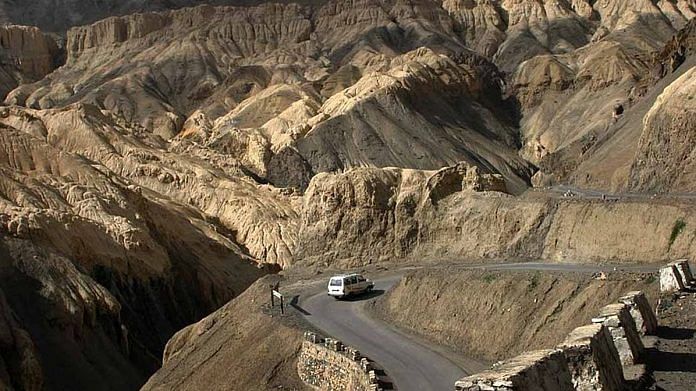New Delhi: Union Home Minister Amit Shah introduced the Jammu and Kashmir Reorganisation Bill, 2019 in Parliament earlier this week, which proposes to bifurcate the state of Jammu and Kashmir into two union territories. Shah had announced the proposal to turn Jammu and Kashmir into a Union Territory with a legislature and Ladakh into a separate Union Territory without a legislature.
Ladakh has been considered a part of Jammu and Kashmir since Independence. But the region was an entirely different entity some 180 years ago.
With the Narendra Modi government undoing a historic merger of not only two pieces of land but also their cultures and civilisations, a look at how and why they were brought under a common rule in the first place.
Inhabited by nomadic tribes
The word ‘Ladakh’ emanates from a local word, ‘La Dak’, meaning ‘land of the mountain passes’ — ‘La’ (mountain passes) and ‘Dak’ (country). The region was also known as ‘Maryul’ or low land in the past. Ancient Chinese travellers Fa-Hein and Hiuen Tsang referred to it as ‘Kia-Chha’ and ‘Ma-Lo-Pho’, respectively.
The primary inhabitants of this land are believed to be the Brokpas. This community claims to be members of Alexander’s army which had stayed back. Ladakh has been inhabited by various nomadic tribes at different points of time such as the Dardis near Kargil and Tibeto-Mongolians around Leh, Lahaul and Spiti.
The earliest known reference to political rule in Ladakh was found in an ancient Indo-Aryan language of the Kharosthi script. This inscription refers to the rule of Kushan Emperor Kaniska from 78 to 144 CE.
Based on references found in Tibetan and Arab literature, it has also been said Skitde Nemagon had ruled the region in the 10th century AD.
Nemagon’s kingdom was taken over by King Singge Namgyal who built the historic 9- storey Leh Palace.
Cambridge Scholar John Gray has written that until 1834 when the first Dogra invasion took place, Ladakh was an independent Himalayan state akin to Bhutan.
He also says Ladakh was part of the Tibetan empire which disintegrated after the assassination of King Langdarma in 742 AD. Thereafter, it became an independent kingdom but its borders remained dynamic at different periods of history.
Also read: Art 370 killed because Hindu Jammu, Buddhist Ladakh & Muslim Kashmir only benefitted Pakistan
Rise of Sikh Empire
The Namgyal kings had protected Ladakh from Tibetan threat in the East and the rulers of Kashmir in the West. In the 17th century, Lahaul and Spiti were lost to the Rajas of Kullu but rest of the region remained independent till the rise of Maharaja Ranjit Singh of Punjab in the early 19th century.
Ranjit Singh defeated several kingdoms in north-west India and established a Sikh empire. In 1808 CE, he took over Jammu from the Dogras, while Kashmir was annexed to the Sikh empire in 1819.
In 1802, a weak Namgyal dynasty approached General Zorawar Singh of the Sikh Empire for administrative help. Zorawar Singh marched into Ladakh in 1834.
Ladakh was a strategically important region for both the Dogras and the Sikhs since it oversaw trade routes from Tibet to the rest of India.
Ironically, the Ladakhis had offered to accept British supremacy in 1822 in return for protection against the Sikh empire. The British administration, however, refused to intervene because Ladakh was considered “agriculturally barren”.
By 1835, the king of Ladakh was forced to sign a treaty accepting supremacy of the Sikh empire and to pay an annual tribute to it. Subsequently, in 1841, Raja Gulab Singh of Kashmir finally annexed Ladakh. The Namgyal ruler was given a small jagir (a grant), now known as Stok Palace outside Leh. It is now a heritage hotel.
Becoming a part of J&K
According to the Treaty of Amritsar (1846), Raja Gulab Singh was awarded the kingdom of Jammu and Kashmir, which included Ladakh. This inevitably made Ladakh a part of the princely state of Jammu and Kashmir. Post Independence, the region continued to be a part of Jammu and Kashmir.
In 1979, Ladakh division of Jammu and Kashmir was divided into two full-fledged districts of Leh and Kargil. It has one Lok Sabha constituency and two assembly constituencies. This Lok Sabha seat will continue to present Ladakh but the state-level representation will be dissolved since Ladakh will now be a separate Union Territory without a legislature.
Also read: Modi govt’s move to make Ladakh a UT reopens an old front with China
What upsets China
China has been particularly critical of India’s decision to turn Ladakh into an administrative territory directly ruled by the central government.
The neighbouring country claims a 90,000-square-kilometre chunk of Arunachal Pradesh and Ladakh — due to the continuing dispute over Aksai Chin.
Pakistan and China had illegally occupied around 78,114 sq km and 37,555 sq km areas of Ladakh, respectively, post Independence. The dispute over Ladakh started when Pakistan ceded 5,180 sq km of the region to China in 1963.
Following this, there have been several intrusions into Ladakh by Chinese army along the Line of Actual Control. One of the most significant ones took place in April 2013 when Indian and Chinese troops camped in front of each other at Daulat Beg Oldie for three weeks.



